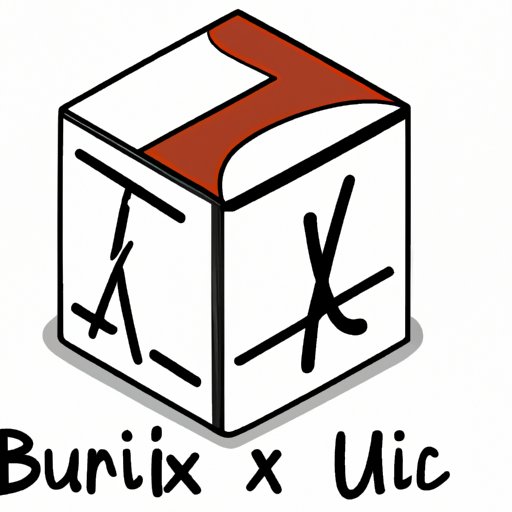
I. Introduction
If you aspire to be a proficient artist, it is imperative to have a good grasp of the fundamentals. Drawing cubic objects is an essential skill for anyone who wishes to excel in the art of drawing. It lies at the heart of various types of art, including architecture, interior design, animation, and more. This article will guide you through the process of drawing cubic objects, from the materials needed to the techniques required to add realism to your creations. You will learn how to create a well-balanced composition with multiple cubic objects and how technology and online resources can enhance your drawing abilities.
II. Materials Needed
The following materials are essential for drawing cubic objects:
- Graphite pencils of different hardness levels: HB, 2B, 4B, 6B, and 8B.
- Eraser- a kneaded rubber eraser.
- Paper or sketchbook of medium thickness.
- Ruler or T-square.
Graphite pencils have different lead hardness, and you will need them to achieve a wide range of values in your drawings. The softer the pencil, the darker the value, while the harder the pencil, the lighter the value.
III. The Basics of Cubic Drawing
Before drawing cubic objects, it is important to understand the fundamental principles. Cubic objects have straight lines, sharp angles, and square faces. Familiarize yourself with the front, top, and side views of a square to draw cuboids effectively. Avoid these common mistakes while drawing cubic objects:
- Distorted dimensions
- Inconsistent lines
- Wrong placement of angles and perspective
- Disoriented shading
IV. A Step-by-Step Tutorial on Drawing Cubic Objects
To draw a cubic object:
- Start by drawing a square.
- Add sides to the square with perpendicular lines.
- Draw another square parallel to the first one, to create a 2D representation of the cuboid.
- Add depth by drawing vertical lines at the corners of the squares.
- Erase the unnecessary lines and smoothen the edges.
Remember to use a ruler or T-square to ensure your lines are straight and perpendicular. For more detailed instructions with images, visit our website.
V. Understanding the Principles of Perspective for Drawing Cubic Forms
Understanding the principles of perspective is essential for drawing cubic forms, as it helps to create a realistic 3D representation of the object. Perspective refers to the way objects seem to get smaller and closer together as they move farther away from the viewer. To apply these principles to your drawing:
- Draw a horizon line to separate the sky and ground.
- Draw the vanishing point, which is the point where parallel lines meet on the horizon line.
- Draw lines from the edges of the cuboid to the vanishing point to create the correct angles and proportions.
- Add shading and texture to give the object depth and perspective.
VI. How to Shade and Add Textures to a Cubic Object for Realism
Shading and texturing add realism and depth to a cubic object, making it appear more three-dimensional. Here are several techniques you can utilize:
- Blending with a tortillon – helps to create a smooth texture in your drawing.
- Cross-hatching – add a series of parallel lines to add texture and value to your drawing.
- Stippling – use dots to create the illusion of textures.
- Smudging – use your fingers or a blending tool to distribute graphite or charcoal for a softer gradient.
Try different techniques and find the one that works best for you. Don’t forget to pay attention to the light source so that your shading is consistent.
VII. Tips and Tricks for Drawing Multiple Cubic Objects in a Single Composition
When drawing multiple cubic objects in a single composition, it can be challenging to achieve balance and harmony. Here are a few tips on how to plan and place cubic objects within a composition:
- Start by sketching the general composition and placement of each object.
- Use overlapped shapes to add depth and interest to the composition.
- Avoid overcrowding the composition, leaving enough space between each object.
- Vary the sizes and positions of the objects to create a well-balanced composition.
VIII. The Importance of Practicing and Refining Your Skills to Improve Your Cubic Drawing Abilities
As with any skill, practice is essential for improving your cubic drawing abilities. By practicing regularly, you can refine your techniques and develop your own style. Here are a few ways to improve your drawing skills:
- Draw from life – study the real-life objects to understand their dimensions and textures.
- Copy work from other artists to expand your understanding of techniques and styles.
- Join classes or workshops to learn from other artists and receive guidance and feedback.
- Create a routine and draw regularly even if just for a few minutes a day.

IX. Using Technology and Online Resources to Enhance Your Cubic Drawing Techniques
With technological advancements, artists can enhance their drawing techniques using technology and online resources. Tools and software such as digital sketchpads, animation software, and digital painting software can make the drawing process more accessible and efficient. Online resources such as drawing tutorials, forums, and blogs offer an endless supply of knowledge to help you improve your skills.
X. Conclusion
With this step-by-step tutorial, you no longer have to feel overwhelmed when drawing cubic objects. Mastering the art of cubic drawing requires patience, practice, and a keen eye for detail, but the end result is worth the effort. Remember to use the correct materials, understand the principles of perspective, and employ various shading and texturing techniques for a realistic outcome. Keep practicing, and don’t hesitate to experiment with different styles and techniques.




